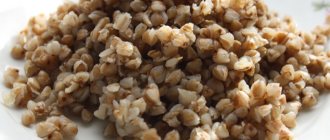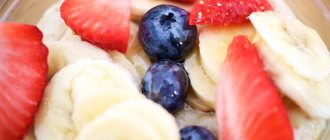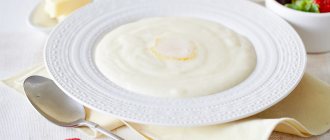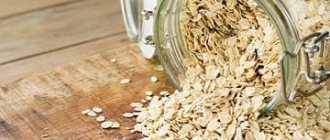Good day, readers and guests of the blog! Today we will talk about children's cereals. When a baby is born and a woman becomes a mother, the most important thing for her is complete and the best, high-quality nutrition for the child. Among all the variety, it is quite difficult to navigate: which porridge is better to choose? Moreover, there are many mixtures based on palm oil, which is undesirable for a child’s body. In addition, many children are allergic to gluten. Let's talk about this topic: is gluten in baby cereals harmful or not for all babies, and I will also present a list of cereals that do not contain this protein.
Is it the gene's fault?
| By the way | |
| Useful information for patients with celiac disease can be found on the websites: celiac.spb.ru, celiac.ru (Information Center for Celiac Disease), agluten.narod.ru, glutenfree.ru (information about gluten-free products). | |
There is such a disease as celiac disease, an intolerance to the protein gluten. This protein is found in almost all cereals, with the exception of rice and buckwheat. In patients with celiac disease, gluten damages the mucous membrane of the small intestine, and it atrophies. As a result, the absorption of food in the intestines is disrupted, not only carbohydrates, but also proteins, fats, vitamins, and minerals. The child loses weight no matter how much he eats and lags behind in both physical and mental development. If the process is not stopped, the outcome can be sad.
Celiac disease is believed to be a hereditary disease, although the gene that causes it has not yet been identified. However, it is impossible to say for sure that parents with celiac disease will give birth to an unhealthy child.
We manage without gluten - we cook it ourselves
Until two years, definitely, and better yet, never use gluten in food at all - this is the motto for a healthy diet.
The following cereals do not contain gluten:
- quinoa;
- green buckwheat;
- amaranth;
- millet;
- corn;
- rice.
Where to begin?
- You should try with 1 tsp. Cook porridge in water. If the child is older, use vegetable or meat broth instead of water.
- You can make your own nut milk. It is lactose-free and easily absorbed by the body. It can be used, but consult your pediatrician.
- First, you need to wash the cereal at a temperature of at least +40 degrees. This will steam the grains and remove starch and accumulated fat from the surface.
- Then soak the seeds with ½ teaspoon of salt in filtered water for at least 3 hours. You can read more about soaking here.
- Then the cereal is placed in boiling water (except buckwheat) and boiled over low heat until tender, stirring lightly. Do not use sugar if you are planning a sweet porridge.
- If you have been going without sugar for a long time, then add no more than 1 tsp to the porridge. honey
How to diversify?
Despite the fact that there are a lot of vitamins in cereals, everything is done according to the rules - the child sometimes refuses to eat porridge. This is due to the fact that the baby's taste receptors are much more sensitive. He reacts to even the slightest deviations: too much or little salt, too sweet, porridge overcooked.
- To diversify the menu, add raisins (if there are no allergies), seeds, nuts to the porridge, add dried or fresh fruits, or candied fruits.
- A wonderful second course is prepared for children based on porridge. The list is small, but turkey, chicken, and rabbit meat are suitable. Try to use the lightest and most dietary meat. You can add steamed onions or lightly fried in olive oil. Buckwheat porridge with onions turns out very tasty.
- Only 163 kcal is contained in 100 grams of buckwheat, which is equal to half a bun. If you prepare it the night before, you can top it with nut milk in the morning.
Is there gluten in beans and peas? Read about it here.
If the information was useful to you, then share it with your friends and subscribe to updates. I look forward to your comments on the post. See you Bye!
I look forward to your comments on the post. See you Bye!
Three masks of illness
Signs of celiac disease manifest themselves in different ways, so doctors distinguish between typical, atypical and latent (hidden) forms of the disease.
Typical celiac disease appears a month or two after introducing gluten-containing foods into a child’s diet.
If, for example, a baby is given gluten-containing cereals at the end of the first six months of life, at 8–9 months the first symptoms of the disease appear: copious, loose stools with a grayish tint and a large belly. A patient with typical celiac disease is sometimes compared to a spider: a huge belly and thin arms and legs.
In the first stages of the disease, the child may be agitated, even aggressive. But in subsequent stages, excitability gives way to apathy and loss of interest in others. Appetite worsens, the functioning of the whole body is disrupted, the patient develops pain in the joints, hair falls out, caries appears...
However, the disease can manifest itself later. It is often noticed in the second year of life. Symptoms appear earlier, but they are not so pronounced as to attract the attention of parents.
Atypical celiac disease is insidious in that it manifests itself with only one symptom. It is also called monosymptomatic. Anemia may be such a symptom. But there are many diseases in which a person develops anemia, so it is not easy to determine celiac disease only by this sign.
There is also latent celiac disease, which does not make itself felt in any way; it can only be detected with the help of special studies. For the patient with latent celiac disease, the disease is not dangerous, but it can be inherited.
Which cereals are gluten-free?
Pediatricians strongly recommend choosing gluten-free cereals for complementary feeding, such as buckwheat, rice and corn. Each of the cereals contains vitamins, minerals, and benefits the child’s body.
Experts recommend buckwheat porridge for first complementary feeding. It is well absorbed and digested. Contains vitamins B, E, A, PP, minerals phosphorus, potassium, magnesium, zinc, copper, calcium, silicon, amino acids lysine and arginine.
It is better to cook buckwheat in water. You can add breast milk or an adapted formula to it. Buckwheat has a beneficial effect on the functioning of the brain, heart, and nervous system. Rice porridge is also good for first feeding. This dish is recommended for children prone to diarrhea. It rarely causes allergies and helps cleanse the body of toxins.
Rice contains vitamins B, PP, E, manganese, potassium, copper, zinc, iron, phosphorus. This cereal has a beneficial effect on the child’s nervous system, improves sleep, and gives a long-lasting feeling of fullness. Rice also strengthens the heart, blood vessels, and bones.
Rice porridge is especially recommended for babies suffering from diarrhea.
A child should be introduced to corn porridge after introducing buckwheat and rice. This cereal contains vitamins B1 and B2, A, E, starch, iron, copper, nickel, calcium, protein, fiber and other beneficial substances. Corn grits are especially recommended if you are prone to constipation. It helps improve digestion and intestinal function.
Difficulties in diagnosis
The most accessible way to determine celiac disease is to detect antigliadin and antitransglutaminase antibodies in the blood. To do this, blood is taken from a vein and a serological test is performed.
However, doctors do not always receive 100% accurate information after such a study; they often have to do a biopsy of the mucous membrane of the small intestine. In the hands of an experienced specialist, this procedure is quick and painless.
The diagnosis is made based on the combination of the clinical picture, biopsy data and serological examination. The problem arises if the patient has already started a gluten-free diet before a comprehensive evaluation. With a gluten-free diet, many changes quickly go away, the intestinal mucosa begins to recover and the level of antibodies in the blood decreases. Therefore, during diagnosis, a diet cannot be prescribed. In such situations, sometimes it is even necessary to conduct a provocative test.
Rules for introducing complementary foods
Gluten-free cereals are allowed to be introduced to infants from six months, and to artificial infants from 4-5 months. They are included in the diet after introducing the baby to vegetable puree. Food should be liquid, without lumps.
It is boiled from whole grain cereals, and then ground to a puree. You can also make porridge from flour. When introducing gluten-free porridge, it is important to start giving it with a minimum portion - half a teaspoon.
If the child does not experience any negative symptoms during the day, then the volume is gradually increased to 150 grams.
Treatment in limitation
| Important | |
| Gluten is found in: wheat (and therefore semolina), barley (pearl barley), oats, rye, sausages, ketchup, soy sauce, some seasonings and spices, concentrated soups or bouillon cubes, crab sticks, oriental sweets, filled chocolates... Gluten is also found in some cosmetic products, in envelope glue, so in the West they are very careful that all products are labeled. On gluten-free products, a crossed out ear is depicted. | |
The main direction in the treatment of celiac disease is a lifelong gluten-free diet. This is a very important point. If the diet is not followed, patients with celiac disease are at risk of developing cancer.
The insidiousness of the disease lies in the fact that children who follow a diet recover in all respects, and at some point parents may have the illusion that their child has recovered and can now eat any food. This is the deepest misconception!
Dieting for children is not easy. They all love cookies, waffles, and buns, but parents don’t always know which products contain gluten and which do not. Unfortunately, not all our products are labeled for gluten content.
In addition to diet, patients sometimes have to be prescribed other therapy, depending on the changes that have occurred in their gastrointestinal tract and internal organs. They can receive drugs to correct intestinal microflora, pancreatic enzymes, iron for anemia, calcium for bone tissue damage.
How to cook gluten-free porridge
To cook porridge for your baby yourself, you need to take gluten-free cereal and grind it using a coffee grinder. Then slowly pour it into a bowl of boiling water. To prevent lumps from appearing, you must stir constantly. After 15-20 minutes of cooking over low heat, you can remove the dishes and leave the porridge covered for another 10 minutes. For taste, you can add 2-3 drops of vegetable oil.
Important! You should not add salt or sugar to the dish; they do not benefit young children.
For babies under one year old, the norm for sugar consumption is 20-25 grams per day. And starting from 7-8 months, you can diversify the taste of porridge with the help of fruits.
What is possible?
Patients with celiac disease can eat: meat, fish, vegetables, fruits, eggs, dairy products, legumes, chocolate, marmalade, marshmallows, and some types of ice cream. If we talk about newborns, then almost all modern milk formulas and all medicinal formulas do not contain gluten. If gluten-containing components are present in them, this is always indicated on the packaging.
Today, Western gluten-free products have appeared on our market. Some domestic manufacturers are also starting to produce such products, but there are not very many of them yet.
Useful tips
When feeding a baby, parents need to consider that:
- Not only cereals with gluten are not suitable for first feeding, but also porridges containing flour, oat or wheat infusion;
- It’s worth holding off on eating porridges made from several types of grains;
- if the product contains cookies, then it is prohibited, since in the manufacture of cookies, wheat flour containing gluten is usually used;
- When buying ready-made gluten-free cereals for your child, it is better to give preference to products with added calcium and vitamin D.
Where to start and how to give
For the first complementary feeding, you can choose special “store-bought” cereals, which are replete with the shelves of pharmacies and children's stores. Their composition is balanced and ideally selected for a specific child’s body. Moreover, each of them is hypoallergenic and incredibly easy to prepare. Or you can make your own flour from cereals at home. How? I talked about this in the article which porridge to start complementary feeding with.
Initially, you need to introduce dairy-free one-ingredient cereals into the diet, first offering the baby 2-3 teaspoons of the product, and then gradually increasing the volume.
Pediatricians advise giving gluten-free grains in the following order for both infants and formula-fed infants:
- Buckwheat. The queen of cereals and fields contains a maximum of protein, vitamins and microelements, which is why it is ideal for first feeding.
- Corn. Protein, iron and fiber are not a complete list of useful substances found in corn grits, so you can and should offer it to your baby.
Between the introduction of each new cereal, it is necessary to maintain a break of 2 weeks, starting acquaintance with the product only if no unpleasant consequences are detected.
The main rules and principles for the correct introduction of complementary foods can be found here.
Do you have suspicions that the baby is crying from malnutrition, and not from nutritional problems? Then it’s time to check with your pediatrician whether you can give your baby gluten-free milk porridge. Ideally, they are offered no earlier than 4 to 5 months after the introduction of dairy-free foods, but each child is individual, so minor deviations from the rules are possible under the close supervision of a specialist.
The benefits of milk are obvious: it contains vitamins, microelements, fat and protein, which, accordingly, increases its nutritional value. The principle of introducing gluten-free milk porridges does not differ from the rules for introducing other products.
Meanwhile, we have already discussed that it is many times healthier to cook porridge not with milk, but with an adapted mixture, which reduces the risk of an allergy to cow's milk and increases the nutritional value and vitamin content of the product.
By the way, cereals are not the only possible option for starting complementary feeding; read about this in the article on where to start your baby’s first complementary feeding.
Gluten-free products: what is it and why?
You've probably already encountered such cereals when, on your next trip to the store, you looked at boxes of baby food with a special symbol - a crossed out spikelet. It is this designation that is adopted for labeling gluten-free porridges, because gluten is a protein of plant origin, which is part of the shells of some cereal crops (rye, wheat, oats).
The enzyme for its breakdown begins to be produced in the baby's body later than 6 months or is not produced at all - in this case we are talking about an allergy to gluten, so it is quite natural that semolina (from wheat) introduced at the age of 6 months leads to the most unpleasant consequences.
Review of brands of gluten cereals for children
| Brand | pros | Minuses | Price |
| Agusha | Easily dissolves, pleasant taste and reasonable price | Small packages and expiration date after opening | from 100 rubles (200 g) |
| Baby | Wide selection of gluten-free and dairy-free cereals, pleasant taste | They are consumed quickly, contain soy or soy lecithin, which is harmful for babies | from 130 rubles (200 g) |
| Vinny | Easily and quickly digestible, contains prebiotics and vitamin B, pleasant taste and low price | Some cereals contain sugar | from 90 rubles (220 g) |
| Baby | Quick preparation, pleasant aroma and affordable price | Dilutes poorly, lumps form | from 120 rubles (220 g) |
| Nestlé | A wide selection of products from different grains and with different additives, including vitamins, probiotics and bifidobacteria | Contains lecithin, which may cause allergies | from 97 rubles (200 g) |
| Samper | Tasty and healthy porridge with vitamins and minerals, special grain processing, easy to breed | High price | from 217 rubles (220 g) |
| Swaddle | Wide range, easily diluted and dissolved | High carbohydrate content, some types of cereals contain sugar | from 150 rubles (250 g) |
| FrutoNanny | The most accessible and cheap porridge, pleasant taste and convenient packaging | High gluten content | from 33 rubles (200 ml) |
| Heinz | Quick and easy preparation without lumps, pleasant aroma and taste | Some cereals contain a lot of unnecessary additives | from 80 rubles (200 g) |
| Hipp | Natural composition without additives or impurities, pleasant aroma and taste, contains vitamins, minerals and probiotics | High price | from 160 rubles (200 g) |
| Humana | Wide selection of cereals, easy to mix, contain vitamins and minerals | High price | from 240 rubles (200 g) |
When choosing a particular brand, take into account the individual characteristics of the child.
Do not forget that pediatricians do not recommend including gluten cereals in the diet of a nursing mother, at least in the first six months of lactation. Read more about the breastfeeding menu here. Subscribe to our VKontakte group











